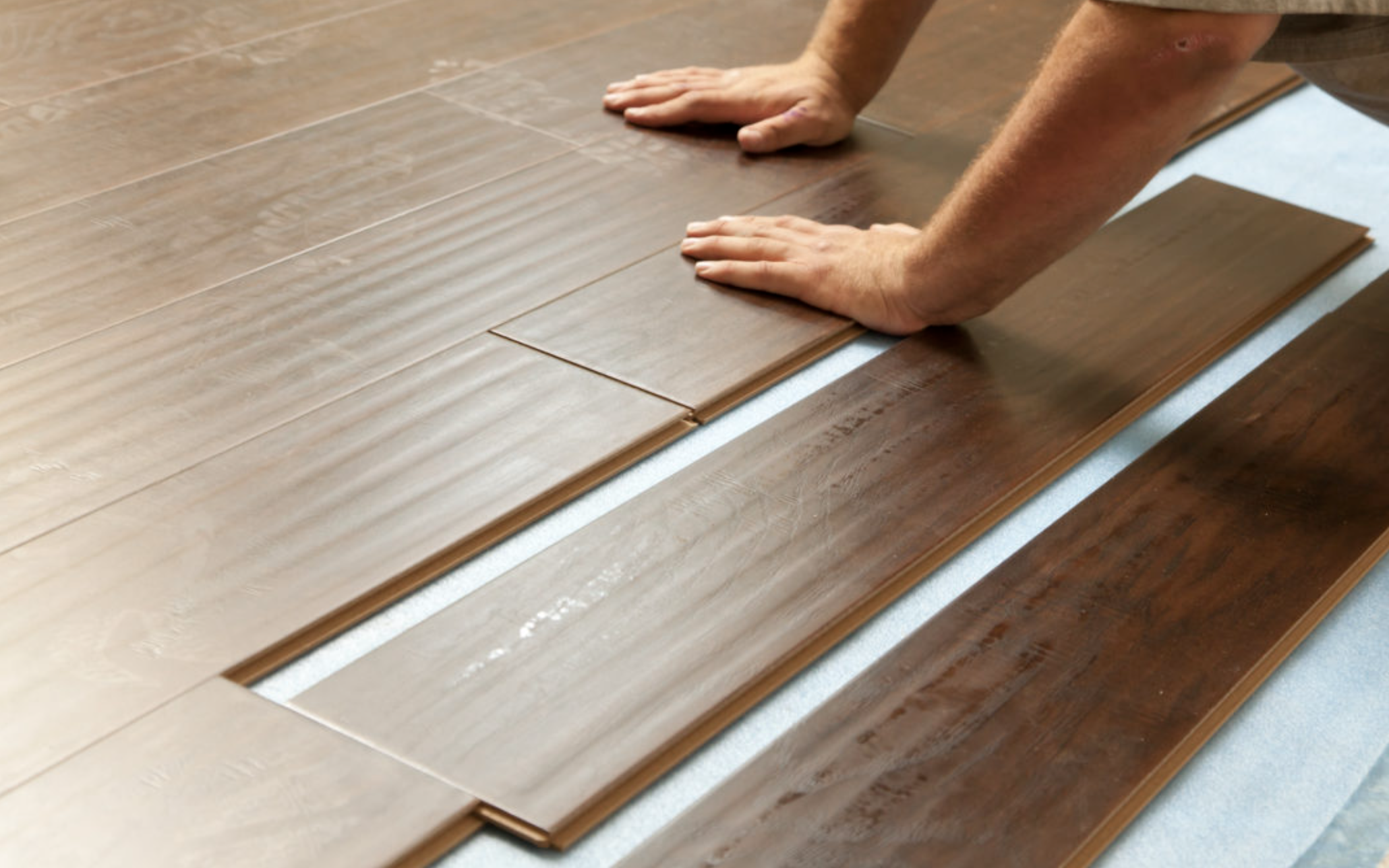Laminate flooring has a reputation for being durable and easy to install. Laminate floors are easy to clean, hypoallergenic, and compatible with children and pets. However, when you consider that a laminate floor must be replaced every 10 years and requires moisture barriers, level subfloors, and trim finishes, a professional can save you expense and frustration.
Benefits
Laminate floors are cheaper than hardwood floors initially. Hardwood floors last 50 to 100 years and can be refinished if damage occurs. Laminate floors last 10 years and cannot be refinished. When damaged, laminate floors must be replaced. Over 50 years, the cost of a hardwood floor averages $400 per year compared to laminate floor $1000 per year.
Laminate flooring resists abrasion, everyday debris, and pet claws. Hardwood floors are susceptible to moisture and humidity limiting their applications in design. Laminate floors are more versatile. Laminate floors do well in below the ground installations such as basements. Laminate floors are rated for durability and harder than most hardwood floors. Abrasion Class (AC) ratings set the standard for 5 categories of use and durability. The higher the rating, the higher the price. Pick the AC rating that matches your needs.
- AC1 Moderate Residential. Built to withstand only light residential use. Suitable for closets or bedrooms.
- AC2 General Residential. Built for moderate foot traffic. Suitable in residential spaces that don’t see a tremendous amount of wear and tear like dining rooms or living rooms.
- AC3 Heavy Residential/Moderate Commercial. Built for all kinds of residential use including high–traffic rooms like family rooms and even commercial spaces that have light traffic like offices without off-street traffic, and hotel rooms.
- AC4 General Commercial. Built to withstand every kind of residential use as well as more heavily trafficked commercial spaces that have off-street traffic like offices, cafes, and boutiques. This floor will do well in a kitchen.
- AC5 Heavy Commercial. Built for the busiest commercial uses and high–traffic spaces like department stores and government buildings.
Installation
Laminate floors are designed with a glueless locking system to be quickly installed throughout the home. Set a budget. Decide what AC rating to place in each room. Design the room by picking color and style. Accept delivery of flooring a week before installation to allow time for acclimation. Acclimation prevents buckling and warping by allowing the product to get used to the humidity and temperature in the room.
The condition of the house is a big factor in the decision to hire a professional installer or Do It Yourself (DIY). If the home has level floors, sturdy subfloors, and simple trim plan, then DIY will be okay. If the home needs underlayment moldings, transition pieces, trim, and adhesives, then hiring a professional will save your frustration and money.
Underlayment is a thin foam padding that absorbs sound and hides minor imperfections in the subfloor. If the floor is going into a basement or below grade, a moisture barrier will also be needed. You can buy laminate with pre-attached underlay.
There are two types of laminate. Direct Pressure Laminate (DPL) or High-Pressure Laminate (HPL). HPL is the strongest since the top and bottom layers are treated separately then fused onto the core. HPL is suitable for very heavy traffic use and is used in commercial properties.
Problems
- Slippery surfaces can cause falls. Spilled liquids must be cleaned promptly to prevent damage from pooling and falls. Floor runners and small rugs need to have non-slip backing. Never wear socks on laminate floors to prevent slipping. Wear gripper socks or rubber soled slippers.
- Scratches and surface damage can occur from high heeled shoes, cleats, and furniture legs. Apply felt sliders on all mobile furniture, like dining room chairs, to protect the floor surface. Remove shoes at the door.
- Bubbling occurs when liquids seep into the seams between the floorboards. Clean spills promptly. Use non-slip backed rugs in high-risk areas like by a kitchen sink. Keep some spare boards on hand so that you can replace damaged boards easily. Buying 10 percent extra boards at time of purchase is a good rule of thumb.
- Color fading will occur over time. Laminate floors have a UV-resistant layer on the surface to protect against sunlight. Generally, light-filtering window coverings will block less light than room-darkening treatments. Opaque materials with thicker weaves, fibers, and yarns block light, while sheer, semi-opaque fabrics invite more light into your home. To lighten your room, put in roman shades in a neutral color and use side drapes for style. Adjusting curtains by using sheers will diffuse sunlight and offer some protection to the laminate floors. Rotating furniture will prevent specific wear patterns from developing.
- Peaking or crowning is when the laminate floor lifts at the seams. The issue is related to weather and climate. Extreme weather, very dry or very wet, will prevent proper expansion and shrinkage of the boards. Even though laminate floors are synthetic material, they still need to move with climate changes. The solution to peaking is to plan during installation. Installing an expansion gap around the flooring area will take care of heat envelope issues and moisture concerns.
- Maintenance is simple, use a soft bristle broom, a damp mop, dust mop, or vacuum without the roller bar activated to prevent scratches. Use eco-friendly, green products that have LEED MR4c 4.1-4.2 recycled content status to clean floors.
Laminate flooring durability depends on installing the right expansion gap and using the correct trim to allow the floor to respond to climate changes. Professional installers will prevent problems and ensure a long life for your laminate floors.

